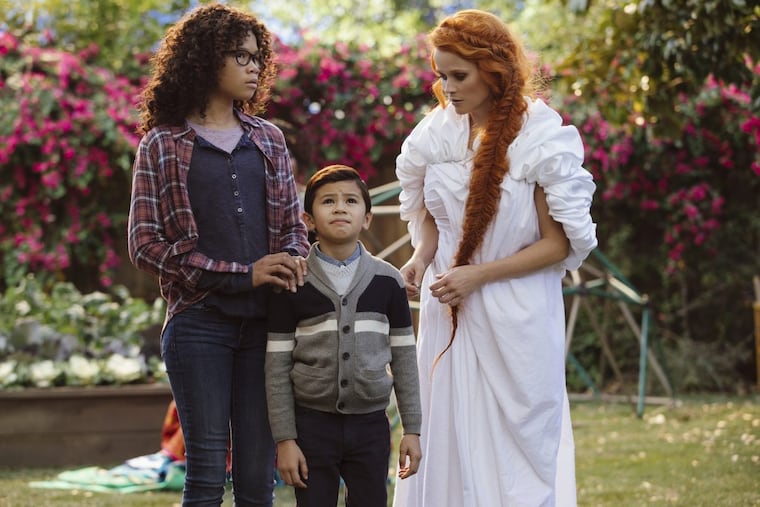Ignore the critics: Take your children to see 'A Wrinkle in Time' | Elizabeth Wellington
Take your kids to see "A Wrinkle in Time" because there is something about a young girl who learns to accept herself exactly how she is and who succeeds - not despite of, but because of her flaws - that throws a monkey wrench in the expectations of the status quo.

When I bought my ticket to see A Wrinkle in Time, I had no idea what I was getting into.
Unlike the zillions of elementary school children before me, I'd never read the late Madeleine L'Engle's science fiction novel about young Meg Murry's trip through the fifth dimension to find her physicist father with the help of magical beings Mrs. Whatsit, Mrs. Who, and Mrs. Which.
But now that I've seen the movie and speed-read my way through the book, I wonder what took Oprah Winfrey so long to get to making this movie. She didn't — Ava DuVernay, the director behind Selma, did — but her imprint is all over it. It's basically a Super Soul Sunday for teens and tweens.
There are big differences between the 1962 novel and the 2018 film. But the point of the story is clear: young girls are fantastic. They can achieve amazing things exactly how they are. All they need to do is trust the process, get in the flow, know that love conquers all, and, most important, let the universe guide them.
Still — sigh —the critics didn't seem to like it.
Wrinkle grossed a lackluster $33.3 million during its opening weekend, coming in second to Black Panther. Some of the complaints: the story line was disjointed and there was too much computer-generated imagery.
I think DuVernay's cinematic interpretation of Wrinkle — beautifully filmed in Los Angles and New Zealand — was unsettling to those of us who prefer that our heroes ripple with muscles and ooze unbridled confidence. It also helps when they morph into something other than themselves to achieve their super-humanness.
But what makes Meg Murry special is she learns to accept herself exactly how she is and succeeds, not despite of, but because of her flaws.
Too many young girls — including myself — grow up to be women who long to be someone or something we aren't.
Thinner. Taller. Smarter. Less like our mothers. More like our mothers. Just like the mean girl who torments us.
What if we knew beyond a shadow of a doubt that we didn't need Botox? What if we didn't need male admiration — although nice — to feel whole?
What if we learned this around age 12, like Meg?
The biggest criticism, however, is that DuVernay strayed too far away from the novel. I think that's the movie's biggest strength. It's what makes it relatable.
In the movie, Meg (Storm Reid) is tormented by Veronica Kiley (Rowan Blanchard), whom she doesn't like but wants to be like. But Meg's great lesson is that she should be exactly who she is, in all her curly haired, tomboyish glory.
Take Mrs Whatsit (Reese Witherspoon), Mrs. Who (Mindy Kaling), and Mrs. Which (Winfrey), who aren't fuddy-duddy hags like they are in L'Engle's Wrinkle. On the big screen, these women are vibrant and full of personality; their makeup is fierce and their metallic wardrobes are nothing short of amazing. In the book, Mrs. Which is an ethereal being who can barely get a word out because talking for her is difficult on the earthly plane. Winfrey's Mrs. Which is solid and doesn't mince words.
In DuVernay's version, these characters become something to aspire to, just as Meg is.
What I found most rewarding, even as an adult, is that a big lesson from the movie is to look inward because you have the answers inside yourself already. A male seer urges Meg, her brother Charles Wallace (Deric McCabe), and fellow traveler Calvin (Levi Miller) to get in tune with their inner selves using breath and yoga's hard-to-balance tree pose.
I love it.
It should be noted that much has been made about the biracial Murry family, who are white in the book. The accomplished Mrs. Murry, Meg's mom, is African American (Gugu Mbatha-Raw). Meg's dad (Chris Pine) is white.
Meg and Charles Wallace look and act eerily like my 12-year-old niece and 6-year-old nephew, right down to their cafe au lait complexions. The way they fight and love each other is refreshing. The race of the protagonists has nothing to do with the story.
It doesn't matter what colors the Murry family are. A couple of weeks ago, we celebrated Black Panther because of its depiction of race. But we celebrate Meg Murry because she's a girl. She's an awesome girl.
Take your daughters (and sons), nieces (and nephews), best friend (and husband) to see Wrinkle because you not only dare to dream, you absolutely, unequivocally love yourself exactly how you are. And you want all the little girls in your life to think so, too.